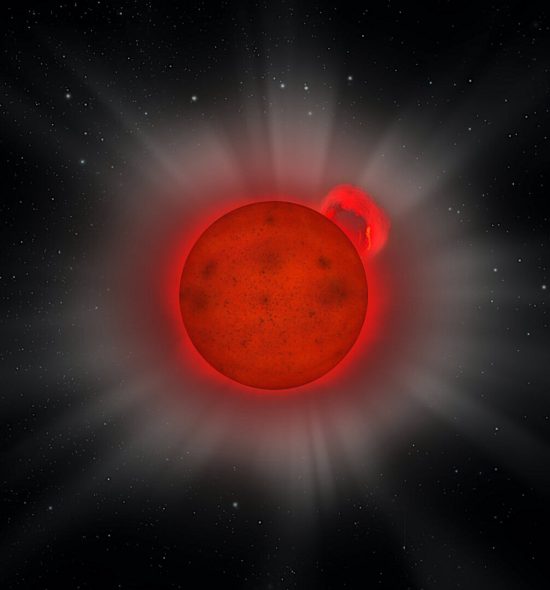
February 24, 2020
What causes stars to expel large quantities of matter?
“The lonely sunsets flare forlorn
Down valleys dreadly desolate;
The lonely mountains soar in scorn
As still as death, as stern as fate.”
— Robert W. Service
XMM-Newton was launched on December 10, 1999 from Kourou, French Guiana. At the time, it was the largest science satellite ever built in Europe. As an X-ray space observatory, XMM-Newton’s detectors are the most sensitive ever developed.
Recently, astronomers studying a kind of star called an L dwarf—a star that, according to astrophysicists, possesses so little mass that it barely qualifies as a star—found that it was ejecting a massive flare: a “super flare” of X-rays. J0331-27 has a low surface temperature for a star: 2100 Kelvin compared to the Sun’s 6000 Kelvin, so such energetic emissions are unexpected.
Beate Stelzer, Institut für Astronomie und Astrophysik said:
“This is the most interesting scientific part of the discovery, because we did not expect L-dwarf stars to store enough energy in their magnetic fields to give rise to such outbursts.”
Consensus ideas about stellar evolution and behavior are based on internal energy sources and a phenomenon known as magnetic reconnection. Many Pictures of the Day address magnetic reconnection, so it will not be detailed here. Suffice to say, the theory discounts electricity or external forces in stars, except to acknowledge charge particles, although they are not seen as coming from outside any given star, but from inside it. As the article states:
“Flares are released when the magnetic field in a star’s atmosphere becomes unstable and collapses into a simpler configuration. In the process, it releases a large proportion of the energy that has been stored in it.”
In an Electric Universe, stars are not internally powered by nuclear fusion reactions, they receive their energy from the galaxy in which they live. Field-aligned electric currents are like power lines in space. Since galactic energy systems are variable, input to stars is also variable, causing the episodic outbursts seen in the cosmos. In a giant “lightning flash” of X-rays, stellar flares discharge vast quantities of matter in mere seconds. One of the major questions that astrophysicists have yet to answer is why flares are so substantial.
Earlier last century, Hannes Alfvén found a clue when he was contracted by the Swedish Power Company to investigate some serious accidents that had occurred. A few of the rectifiers used in the power transmission circuits exploded for no apparent reason. When the rectifiers shorted-out, more energy was released than was contained by the plasma flow inside them, because the power from the entire 900 kilometers of transmission line instantly passed through the devices. The result was a catastrophic failure and extensive damage. Alfvén identified the cause as unstable double layers within the plasma flow.
The circuit connecting J0331-27 (and other stars) is of unknown length, but probably extends for thousands of light-years. How much electrical energy might be contained in such magnetically confined “transmission lines”? No one knows, but astronomers are continually “surprised” by the incredible detonations that they observe from galactic jets, supernovae and stellar flares.
It will serve all students of cosmic electricity to remember Alfvén’s comments:
“Double layers in space should be classified as a new type of celestial object (one example is the double radio sources). It is tentatively suggested that X-ray and gamma ray bursts may be due to exploding double layers.”
Stephen Smith
The Thunderbolts Picture of the Day is generously supported by the Mainwaring Archive Foundation.












